

Salvia divinorum - Drugs Forum. Australia Australia was the first country to prohibit Salvia divinorum and salvinorin A.
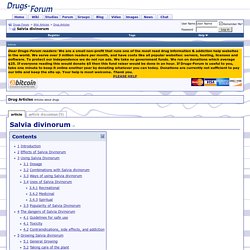
The committee responsible for the ban has admitted that there is "no evidence of a major public health hazard. " The ban went into effect June 1, 2002. Belgium On October 18, 2004 the Belgian government added salvinorin A to their list of controlled substances and took effect November 18, 2004. Brazil In 2005, Brazilian Customs began enforcing a regulation that prohibits importation of plant products without a permit. Canada In a December 2005 report the Marketed Health Products Directorate, an arm of Health Canada, recommended that Salvia divinorum be placed under the Controlled Drugs and Substances Act.
Chile On August 8, 2007, the Chilean government issued a decree making the trafficking of Salvia divinorum and salvinorin A illegal. A Comprehensive Guide to Cooking Meth on ‘Breaking Bad’ Frank Ockenfels/AMC.

Disclaimer: Cooking and/or selling methamphetamine and other controlled substances is illegal unless you are working under the aegis of a pharmaceutical company. As a chemist and someone interested in psychoactive drugs, I’m frequently asked if I watch the AMC series Breaking Bad and if the show accurately portrays clandestine chemistry. I am a huge fan of the show and frequently watch it while working in the lab late at night. Although the clandestine chemistry always appeared accurate at first glance, I desired a more detailed critique of Walter White’s syntheses.
The Big & Dandy HBWR/MGS/LSA Thread - Second Iteration - Page 2. Interview with Alexander Shulgin. A Conversation with Terence Mckenna and Alexander (Sasha) Shulgin 1993. How do you smoke DMT? A Mushroom That Speaks. How to grow magic mushrooms. How Magic Mushrooms Alter Your Brain. Groundbreaking Geniuses And The Drugs They Say Inspired Them.
The Ibogaine Story. "I have seen the best minds of my genertion, starving, hysterical, naked, Dragging themselves through negro streets at dawn, looking for an angry fix...
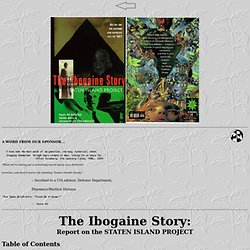
" BBC Horizon: Psychedelic Science - (DMT, LSD, Ibogaine) Ayahuasca. Ayahuasca (UK: /ˌaɪ(j)əˈwæskə/, US: /-ˈwɑːskə/) or ayaguasca[1] (in Hispanicized spellings) from Quechua Ayawaska[2] (aya: soul, waska: vine), or yagé (/jɑːˈheɪ, jæ-/), is an entheogenic brew made out of Banisteriopsis caapi vine and other ingredients.[3] The brew is used as a traditional spiritual medicine in ceremonies among the indigenous peoples of the Amazon basin and is known by a number of different names (see below).[4] B. caapi contains several alkaloids that act as monoamine oxidase inhibitors (MAOIs).
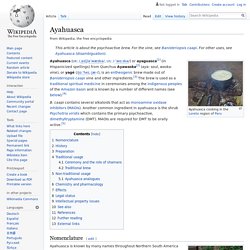
Another common ingredient in ayahuasca is the shrub Psychotria viridis which contains the primary psychoactive, dimethyltryptamine (DMT). MAOIs are required for DMT to be orally active.[5] Nomenclature[edit] Ayahuasca is known by many names throughout Northern South America and Brazil. The Ayahuasca Experience. Ibogaine. Ibogaine is a naturally occurring psychoactive substance found in plants in the Apocynaceae family such as Tabernanthe iboga, Voacanga africana and Tabernaemontana undulata.
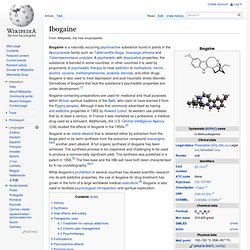
A psychedelic with dissociative properties, the substance is banned in some countries; in other countries it is used by proponents of psychedelic therapy to treat addiction to methadone, heroin, alcohol, cocaine, methamphetamine, anabolic steroids, and other drugs. Ibogaine is also used to treat depression and post traumatic stress disorder. Manual for Ibogaine Therapy. "Regarding the manual I would disagree with some of the exclusion criteria," says one author. "By excluding patients that are depressed or bipolar you exclude a sizable portion of the addict population.
Because ibogaine's metabolites have been shown to have an antidepressant effect it would probably help these patients. Proper treatment for psychiatric conditions can be administered afterward. You will find below some of the experience we have had with patients taking antidepressants prior to ibogaine and since many patients have psychiatric conditions, we don't consider it prudent or necessary to suspend psychotropics for longer than 24 hours before treatment. Below are presented three examples of such patients. Scopolamine: Powerful drug growing in the forests of Colombia that ELIMINATES free will.
Scopolamine often blown into faces of victims or added to drinksWithin minutes, victims are like 'zombies' - coherent, but with no free willSome victims report emptying bank accounts to robbers or helping them pillage own houseDrug is made from borrachero tree, which is common in Colombia By Beth Stebner Published: 22:44 GMT, 12 May 2012 | Updated: 13:43 GMT, 13 May 2012.

A Brief History of the San Pedro Cactus. The Book That Can't Be Read. New signs of language surface in mystery Voynich text - physics-math - 21 June 2013. Read full article Continue reading page |1|2 A mysterious and beautiful 15th-century text that some researchers have recently deemed to be gibberish may not be a hoax after all.

A new study suggests the text shares quantifiable features with genuine language, and so may contain a coded message. The Mush Room. The-mush-room.co.uk is a one stop shop for mushroom enthusiasts and ethnobotanical plant lovers.
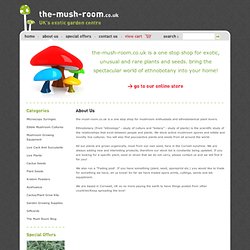
Ethnobotany (from "ethnology" - study of culture and "botany" - study of plants) is the scientific study of the relationships that exist between people and plants. We stock active mushroom spores and edible and novelty live cultures. You will also find psycoactive plants and seeds from all around the world. All our plants are grown organically, most from our own seed, here in the Cornish sunshine. We are always adding new and interesting products, therefore our stock list is constantly being updated. Live salvia plants. Erowid. Psychopharmacology. Czechkyle. Psychopharmacology. An arrangement of psychoactive drugs The field of psychopharmacology studies a wide range of substances with various types of psychoactive properties, focusing primarily on the chemical interactions with the brain.
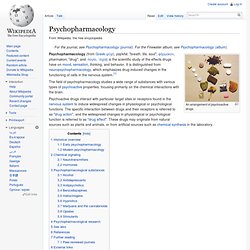
Psychoactive drugs interact with particular target sites or receptors found in the nervous system to induce widespread changes in physiological or psychological functions. The specific interaction between drugs and their receptors is referred to as "drug action", and the widespread changes in physiological or psychological function is referred to as "drug effect". These drugs may originate from natural sources such as plants and animals, or from artificial sources such as chemical synthesis in the laboratory. Historical overview[edit] Early psychopharmacology[edit] The common muscimol-bearing mushroom Amanita muscaria, also known as the "Fly Agaric" Modern psychopharmacology[edit]
Alexander Shulgin. Alexander "Sasha" Theodore Shulgin[2] (born June 17, 1925) is an American medicinal chemist, biochemist, pharmacologist, psychopharmacologist, and author.
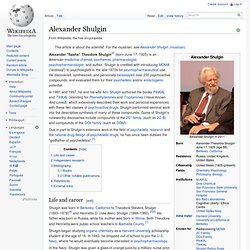
Dimethyltryptamine. History[edit] Another historical milestone is the discovery of DMT in plants frequently used by Amazonian natives as additive to the vine Banisteriopsis caapi to make ayahuasca decoctions. Biosynthesis[edit] Biosynthetic pathway for N,N-dimethyltryptamine This transmethylation mechanism has been repeatedly and consistently proven by radiolabeling of SAM methyl group with carbon-14 (14C-CH3)SAM).[22][20][24][25][26] Evidence in mammals[edit] Psilocybin. Psilocybin[nb 1] (/ˌsɪləˈsaɪbɪn/ SIL-ə-SY-bin) is a naturally occurring psychedelic compound produced by more than 200 species of mushrooms, collectively known as psilocybin mushrooms. The most potent are members of the genus Psilocybe, such as P. azurescens, P. semilanceata, and P. cyanescens, but psilocybin has also been isolated from about a dozen other genera.
As a prodrug, psilocybin is quickly converted by the body to psilocin, which has mind-altering effects similar (in some aspects) to those of LSD, mescaline, and DMT. In general, the effects include euphoria, visual and mental hallucinations, changes in perception, a distorted sense of time, and spiritual experiences, and can include possible adverse reactions such as nausea and panic attacks. History[edit] Early[edit] Modern[edit]
Mescaline. Mescaline or 3,4,5-trimethoxyphenethylamine is a naturally occurring psychedelic alkaloid of the phenethylamine class, known for its hallucinogenic effects similar to those of LSD and psilocybin. It shares strong structural similarities with the catecholamine dopamine. It occurs naturally in the peyote cactus (Lophophora williamsii),[1] the San Pedro cactus[2] (Echinopsis pachanoi) and in the Peruvian torch (Echinopsis peruviana), and as well in a number of other members of the Cactaceae plant family. It is also found in small amounts in certain members of the Fabaceae (bean) family, including Acacia berlandieri.[3] Naturally derived mescaline powder extract. Sacred Peyote. Peyote: I Wish We All Could Be Members of the Native American Church.
St John's wort. Botanical description[edit] Translucent dots on the leaves. High As A Kite. Drugs.